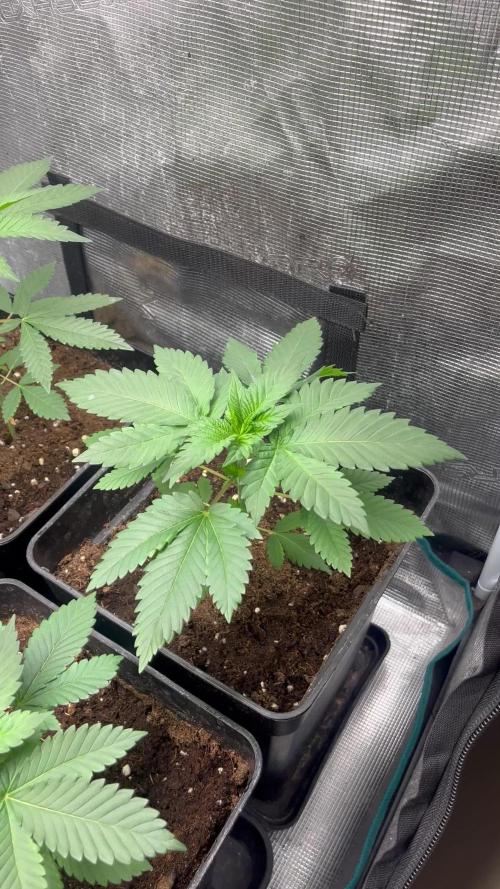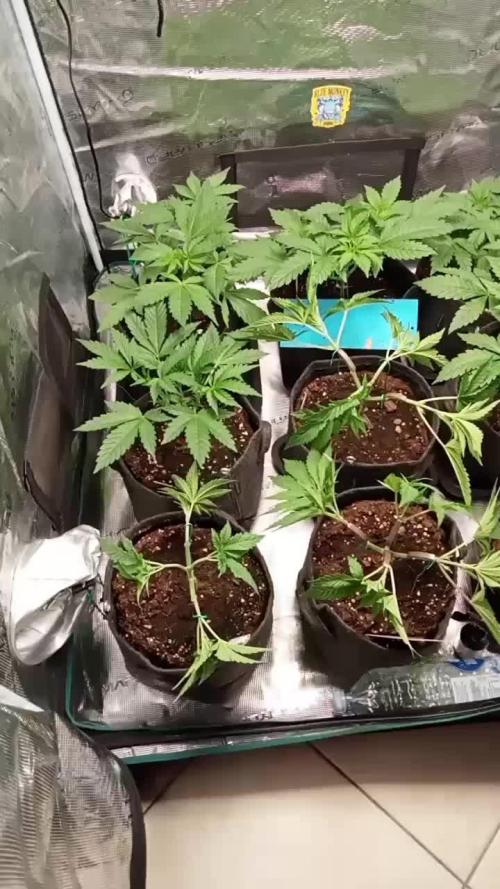The Grow Awards 2026 🏆 





























Likes
98
Share


@Tropicannibis_Todd
Follow
💩Holy Crap We Are Back At It And Loving It💩
Growmies we are at DAY 21 and she's just killing💀it👌
So Shit , I gave them just a tad to much nutes 👈 But I have since fixed it
So I'm starting to pull her over and do some low stress training 🙃
Lights being readjusted and chart updated .........👍rain water to be used entire growth👈
👉I used NutriNPK for nutrients for my grows and welcome anyone to give them a try .👈
👉 www.nutrinpk.com 👈
NutriNPK Cal MAG 14-0-14
NutriNPK Grow 28-14-14
NutriNPK Bloom 8-20-30
NutriNPK Bloom Booster 0-52-34
I GOT MULTIPLE DIARIES ON THE GO 😱 please check them out 😎
👉THANKS FOR TAKING THE TIME TO GO OVER MY DIARIES 👈
Likes
2
Share


@eldruida_lamota
Follow
Vamos familia, actualizamos la quinta semana de vida de estas NoName de Seedstockers.
La temperatura que estuvo entre los 24-26 grados y humedad dentro de los rangos correctos.
Todavía estamos en el ciclo 16 horas luz, 8 oscuridad, estiraron bien y ensancharon bastante también, el color es verde sano.
Se nota que los nutrientes de la marca Agrobeta hacen sus funciones.
También realicé una poda de bajos que yo si las veo necesarias para explotar después la flor.
- os dejo por aquí un CÓDIGO: Eldruida ,descuento para la tienda de MARS HYDRO.
https://www.mars-hydro.com
Hasta aquí todo, Buenos humos 💨💨💨
Likes
13
Share


@Smoke_Weed_Maintain
Follow
Nice dense buds. Pain to trim, but worth it. Seemed a bit nutrient sensitive. I am really impressed with the potent stativa-leaning buzz, will be growing this again, that’s for sure.
Likes
10
Share


@Iamjeeves
Follow
So excited that this grow went well. Just making sure the dry tent stays the right conditions for a slow dry and will trim and weigh these girls before putting them in jars for a few weeks to cure. Sticky and with a earthy fruity berry smell. Maybe a hint of citrus. Can't say enough good things. Happy to luck out with good genetics and optimal conditions during the grow cycle.
Likes
2
Share


@youdan
Follow
la pianta sembra abbia apprezzato il topping con lst quindi probabilmente ne faro un altro a breve.... Forse! Una genetica molto veloce spero vada cosi anche la prossima settimana
Likes
6
Share


@HAN_GROWER17
Follow
Esta semana a estado marcada por un excelente desarrollo, ya esta culminando el desarrollo de los capullos para dar inicio al proceso de engorde de las flores.
Likes
28
Share


@Fatnastyz
Follow
2-24
1 gallon plain water, 6.4.
She may get mad, I didn't add cal/mag.
2-25
Slightly adjusted LST, just to give a little more space. She sure is purdy 😻
Removed few leaves for light. Guy didnt mind.
He had a all you can eat buffet 😂😂
3-1
1 gallon
5 ml cal/mag, 1 ml drops, 20 ml EM 1, 1.5 ml Amplify. Bubbling for 4 hrs. PH 6.4 ish
Ohhh boy, she sure is gonna be happy today. 😁😁
See you next week!
Processing
Likes
11
Share


@w00tGrow
Follow
Californian snow seems to stop progressing, don't know why, any ideas?
Likes
12
Share


@DutchDudeGrow
Follow
25-3
Everything is going fine , this week some heavyer feeding , i allso give
Zoe some foliar feed 1 a day biobizz alg a mic
6-4-2021
some magnesium deficiency i gues , red stripes on the ste,m
Processing
Likes
2
Share


@Pauwela
Follow
8/25 Sat Hurricane Lane downgraded to TS, able to bring girls out of the shed, took off bamboo trellis's, girls from 35"-39" tall, 35 days old,
Likes
8
Share


@Smithsgrow420
Follow
Day 70 really are getting fat now. Is such a leafy strain in itself. Love how the main clone is so big and bushy, can't wait to see all the buds pop.
Day 71 weather is rain, rain and a little bit more. Thinking about putting a roof over the top for a little potetion. The normal UK weather is back. We had a good late run tho. Can't wait to start this plant earlier next year.
Day 72 gave her a feed today upped it to 5% to 1ltr want her to really start to pop out! Beautiful to grow. Weather, been raining all morning and starting to brighten up this afternoon.
Day 73 had to remove the top bud as saw a little fluff deep in there, weather is getting so cold at the moment at night, may more her into a shelter and get a heater for the finishing weeks. Won't be able to take her as long as wanted. Looks amazing tho!!!!!!
Had to move her to to the greenhouse, she doesn't like this rainy weather!!!!
Day 74 had to take a little bit more off today, this evening weather is so cold at the moment. Meant to get warming in a week or so but don't think she will make it till then. Got a heater in there and a dehumidifier to help. May have to cut her all down a bit before I wanted. Will keep checking her all the time. Smells amazing very sweet with a hint of diesel at the moment. Want that diesel smell to over power the sweet sugars. She does look a bit weird with the top cut off, but had to do what I had to do. Removed all of the larger leaves to help keep down humidity.
Day 75 weather is so rainy today, had to give her a pre trim of all the larger leaves today. Buds have really popped in the last couple of day. Kicking myself that I didn't start it early, we had a amazing run of good weather last month. Wish it was the finishing month. But hay ho. Give her the first flush today 1 ltr of just rain water.
Day 76 end of week 11 what a week this has been, really have seen them buds fatten an fatten up. Don't think I'm going to run her for another week, thinking about cropping tomorrow evening. The weather was not on my side at the end of this grow. I believe she has done amazing, was truly a dream to grow.
Likes
3
Share


@Growbody
Follow
Hallo und herzlich Willkommen zu einem etwas anderen Gropwbericht. Die Blueberry Zkittlez Automatic von Sensi Seeds (der Strain heißt jetzt Blueberry Candiez Automatic) hatte ich letztes Jahr bereits angebaut und war vom Geschmack total begeistert. Deshalb baue ich den jetzt wieder an und dazu die Blueberry Automatic von Zamnesia Seeds, die schon einige Zeit in meiner Samenbank liegt. Mal sehen, wie sich die Pflanzen unterscheiden.
Die URL der Blueberry Automatic von Zamnesia Seeds:
https://www.zamnesia.com/de/3323-zamnesia-seeds-blueberry-automatic-feminisiert.html
Die URL der Blueberry Zkittlez Automatic von Sensi Seeds:
https://sensiseeds.com/de/research/blueberry-candiez-automatic
Beide Strains erhalten die gleichen Bedingungen. Beide stehen in einem 9 Liter doppellagigen Stofftopf von ROOTIES (ChillWelten war der Vorgänger der Firma, heute heissen alle ROOTIES), beide haben die Sonnenerde Bio Hanferde und bekommen und später gibt's noch eine Mulchschicht mit Sonnenerde Bio Faser. Beide haben am Anfang eine Bioledex mit 10W im gleichen Abstand.
Tag 60: Die Blueberry Automatic von Zamnesia Seeds hat wie alle anderen SF-Nematoden, Florfliegenlarven, Raubmilben Amblyseius cucumeris und californicus bekommen.
Tag 62: Die Blueberry Auto hat bereits vollkommen reife Blüten, keine hellen Fäden mehr zu sehen. Dagegen sind bei der Blueberry Zkittlez die meisten Blütenfäden noch weis.
Schau mal wieder rein, wenn es dir gefallen hat. Schönes Wochenende und bleibt friedlich und humorvoll. ✋😎
Likes
4
Share


@blaze_fpv
Follow
I came back to the fridge after 6 days and stretch was running massively.
They grew like 20cm in 6 days
I changed my climate to:
27° C 60% rlf in order to adapt to early flower
Day and Night same
45% light about 580ppfd
Still running the water in a circle.
Adjusted the scrog a bit in order to fill the space more
They eat like 1100ppm CO2 an hour 😎
__________________
Update: last 2 videos show day 8 of flower ,🤙🏼
Decided to give them a heavy defoliation due to it being a closed loop system and them emitting tons of humidity.
So far so nice 🏼
Likes
2
Share


@JolliGrowz27
Follow
Blueberry genetics comes through on the exhale. The Kush is in the flavor when you inhale. Spicy inhale fruity finish, great for evening chill. No couch lock though.
Likes
3
Share


@skunk_punk19
Follow
Segunda semana de floración los tricomas son mucho más notables y son grande ,el crecimiento sigue siendo muy acelerado
























